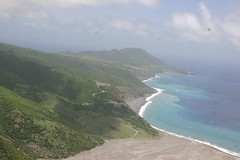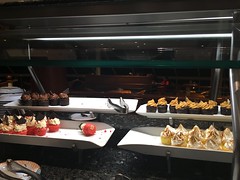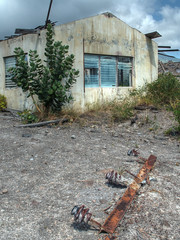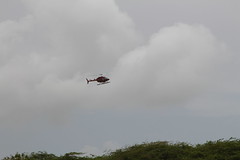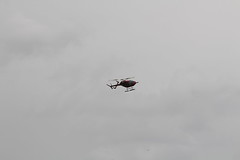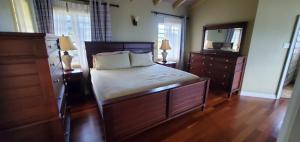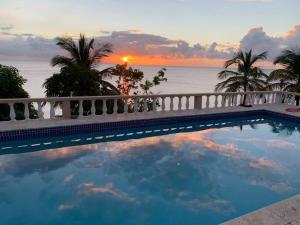 Montserrat
Montserrat
Montserrat (English: /ˌmɒntsəˈræt/) is a British Overseas Territory in the Caribbean. It is part of the Leeward Islands, the northern portion of the Lesser Antilles chain of the West Indies. Montserrat is about long and wide, with roughly of coastline. It is nicknamed "The Emerald Isle of the Caribbean" both for its resemblance to coastal Ireland and for the Irish ancestry of many of its inhabitants. Montserrat is the only non-fully sovereign full member of the Caribbean Community and the Organisation of Eastern Caribbean States.
On 18 July 1995, the previously dormant Soufrière Hills volcano, in the southern part of the island, became active. Eruptions destroyed Montserrat's Georgian era capital city of Plymouth. Between 1995 and 2000, two-thirds of the island's population was forced to flee, primarily to the United Kingdom, leaving fewer than 1,200 people on the island in 1997 (rising to nearly 5,000 by 2016). The volcanic activity continues, mostly affecting the vicinity of Plymouth, including its docking facilities, and the eastern side of the island around the former W. H. Bramble Airport, the remnants of which were buried by flows from volcanic activity on 11 February 2010.
An exclusion zone, encompassing the southern part of the island to as far north as parts of the Belham Valley, was imposed because of the size of the existing volcanic dome and the resulting potential for pyroclastic activity. Visitors are generally not permitted entry into the exclusion zone, but a view of the destruction of Plymouth can be seen from the top of Garibaldi Hill in Isles Bay. Relatively quiet since early 2010, the volcano continues to be closely monitored by the Montserrat Volcano Observatory.
In 2015, it was announced that planning would begin on a new town and port at Little Bay on the northwest coast of the island. While additional plans proceeded, the centre of government and businesses was moved to Brades. After a number of delays, including Hurricanes Irma and Maria in 2017 and the COVID-19 pandemic beginning in early 2020, in June 2022, ground was broken on the Little Bay Port Development Project, a £28 million project funded by the UK and the Caribbean Development Bank.
Etymology
In 1493, Christopher Columbus named the island Santa María de Montserrate, after the Virgin of Montserrat in the Monastery of Montserrat, on Montserrat mountain, near Barcelona in Catalonia, Spain. "Montserrat" means "serrated mountain" in Catalan.
History
Pre-colonial era
Archaeological field work in 2012 in Montserrat's Centre Hills indicated there was an Archaic (pre-Arawak) occupation between 2000–500 BCE. Later coastal sites show the presence of the Saladoid culture (until 550 CE). The native Caribs are believed to have called the island Alliouagana, meaning 'Land of the Prickly Bush'.
In 2016, nine petroglyphs were discovered by local residents hiking in a wooded area near Soldier Ghaut. Another was discovered in 2018 in the same area of the island. The carvings are believed to be 1000-1500 years old.
Early European period
In November 1493, Christopher Columbus passed Montserrat in his second voyage, after being told that the island was unoccupied due to raids by the Caribs.
A number of Irishmen settled in Montserrat in 1632. Most came from nearby Saint Kitts at the instigation of the island's governor Thomas Warner, with more settlers arriving later from Virginia. The first settlers "appear to have been cultivators, each working his own little farm".
The preponderance of Irish in the first wave of European settlers led a leading legal scholar to remark that a "nice question" is whether the original settlers took with them the law of the Kingdom of Ireland insofar as it differed from the law of the Kingdom of England.
The Irish being historical allies of the French, especially in their dislike of the English, invited the French to claim the island in 1666, although no troops were sent by France to maintain control. However, the French did attack and briefly occupy the island in the late 1660s; it was captured shortly afterwards by the English and English control of the island was confirmed under the Treaty of Breda the following year. Despite the seizing by force of the island by the English, the island's legal status is that of a "colony acquired by settlement".
A neo-feudal colony developed amongst the so-called "redlegs". The colonists began to transport Sub-Saharan African slaves for labour, as was common to most Caribbean islands. The colonists built an economy based on the production of sugar, rum, arrowroot and sea island cotton, cultivated on large plantations by slave labour. By the late 18th century, numerous plantations had been developed on the island.
18th century
There was a brief French attack on Montserrat in 1712. On 17 March 1768, a slave rebellion failed but their efforts were remembered. Slavery was abolished in 1834. In 1985, the people of Montserrat made St Patrick's Day a ten-day public holiday to commemorate the uprising. Festivities celebrate the culture and history of Montserrat in song, dance, food and traditional costumes.
In 1782, during the American Revolutionary War, as America's first ally, France captured Montserrat in their war of support of the Americans. The French, not intent on truly colonising the island, then agreed to return the island to Great Britain under the 1783 Treaty of Paris.
Communications
The island is served by landline telephones, fully digitalised, with 3000 subscribers and by mobile cellular, with an estimated number of 5000 handsets in use. An estimated 2860 users have internet access. These are July 2016 estimates. Public radio service is provided by Radio Montserrat. There is a single television broadcaster, PTV. Cable and satellite television service is available.
The UK Postcode for directing mail to Montserrat is MSR followed by four digits according to the destination town, for example, the postcode for Little Bay is MSR1120.
Geography
The island of Montserrat is located approximately south-west of Antigua, south-east of Redonda (a small island owned by Antigua and Barbuda), and north-west of the French overseas region of Guadeloupe. Beyond Redonda lies Nevis (part of St Kitts and Nevis), about to the north-west. It comprises and is gradually increasing owing to the buildup of volcanic deposits on the south-east coast. The island is long and wide and consists of a mountainous interior surrounded by a flatter littoral region, with rock cliffs rising above the sea and a number of smooth bottomed sandy beaches scattered among coves on the western (Caribbean Sea) side of the island. The major mountains are (from north to south) Silver Hill, Katy Hill in the Centre Hills range, the Soufrière Hills and the South Soufrière Hills. The Soufrière Hills volcano is the island's highest point; its pre-1995 height was . However it has grown after the eruption due to the creation of a lava dome, with its current height being estimated at .
The 2011 estimate by the CIA indicates that 30% of the island's land is classified as agricultural, 20% as arable, 25% as forest and the balance as "other".
Montserrat has a few tiny off-shore islands, such as Little Redonda off its north coast and Pinnacle Rock and Statue Rock off its east.
Volcano and exclusion zone
In July 1995, Montserrat's Soufrière Hills volcano, dormant for centuries, erupted and soon buried the island's capital, Plymouth, in more than of mud, destroyed its airport and docking facilities, and rendered the southern part of the island, now termed the exclusion zone, uninhabitable and not safe for travel. The southern part of the island was evacuated and visits are severely restricted. The exclusion zone also includes two sea areas adjacent to the land areas of most volcanic activity.
After the destruction of Plymouth and disruption of the economy, more than half of the population left the island, which also lacked housing. During the late 1990s, additional eruptions occurred. On 25 June 1997, a pyroclastic flow travelled down Mosquito . This pyroclastic surge could not be restrained by the ghaut and spilled out of it, killing 19 people who were in the (officially evacuated) Streatham village area. Several others in the area suffered severe burns.
In recognition of the disaster, in 1998, the people of Montserrat were granted full residency rights in the United Kingdom, allowing them to migrate if they chose. British citizenship was granted in 2002.
For a number of years in the early 2000s, the volcano's activity consisted mostly of infrequent ventings of ash into the uninhabited areas in the south. The ash falls occasionally extended into the northern and western parts of the island. In the most recent period of increased activity at the Soufrière Hills volcano, from November 2009 through February 2010, ash vented and there was a vulcanian explosion that sent pyroclastic flows down several sides of the mountain. Travel into parts of the exclusion zone was occasionally allowed, though only by a licence from the Royal Montserrat Police Force. Since 2014 the area has been split into multiple subzones with varying entry and use restrictions, based on volcanic activity: some areas even being (in 2020) open 24 hours and inhabited. The most dangerous zone, which includes the former capital, remains forbidden to casual visitors due to volcanic and other hazards, especially due to the lack of maintenance in destroyed areas. It is legal to visit this area when accompanied by a government-authorized guide.
The northern part of Montserrat has largely been unaffected by volcanic activity, and remains lush and green. In February 2005, Princess Anne officially opened what is now called the John A. Osborne Airport in the north. Since 2011, it handles several flights daily operated by Fly Montserrat Airways. Docking facilities are in place at Little Bay, where the new capital town is being constructed; the new government centre is at Brades, a short d…



